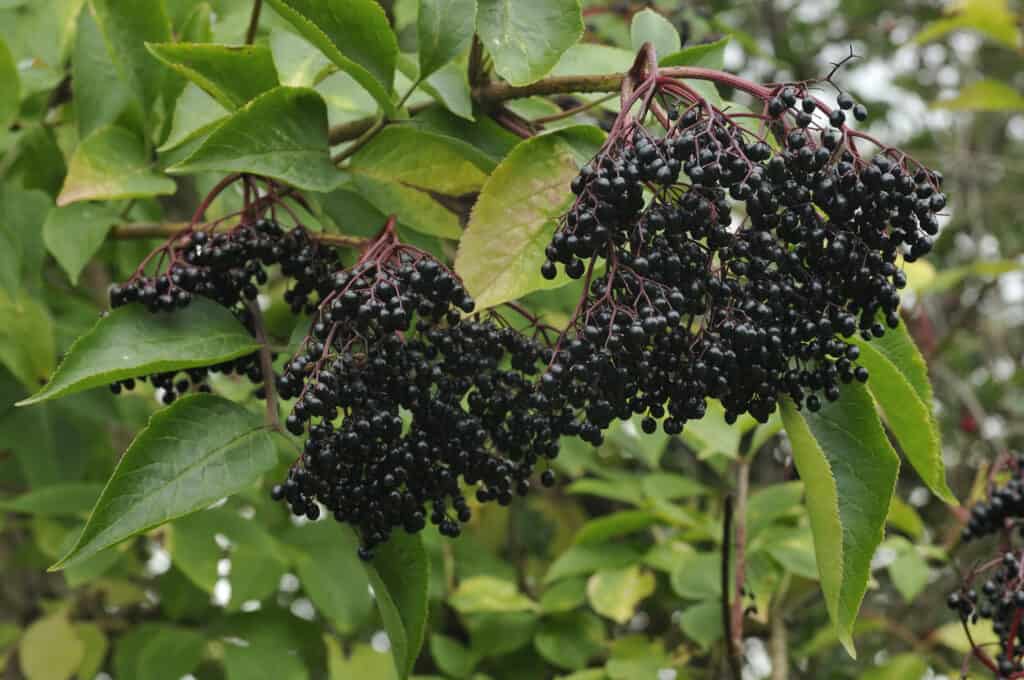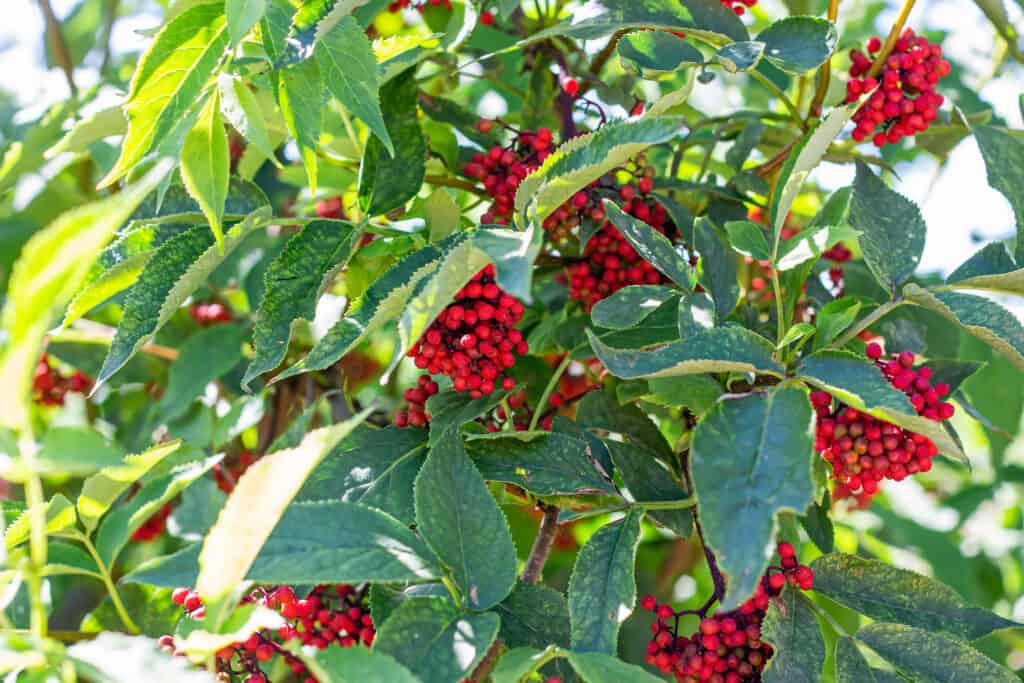If you enjoy lovely shrubs with clusters of pretty flowers and berries that can be cooked into a variety of delicious treats, then you may be smitten with red and black elderberry plants.
Belonging to the Sambucus genus, these elderberry plants have a long history of culinary and medicinal use by people around the world. In this guide, we’ll compare red elderberry vs. black elderberry by discussing their plant classification, physical characteristics, native ranges and ideal growing conditions, culinary uses, and medicinal uses.
So, read on to learn more about these wonderful plants!
| Red Elderberry | Black Elderberry | |
|---|---|---|
| Plant Classification | Sambucus racemosa | Sambucus nigra |
| Physical Characteristics | Deciduous large shrub or small tree that reaches heights of 6-12 feet at maturity with a 6-15-foot spread. Has a multi-stemmed, sprawling growth habit with much upright branching. Leaves are pinnately compound, oppositely arranged, with 5-7 leaflets. Leaf shapes are elliptics-ovate. They are sharply toothed along the margin and bright green. The flowers are tiny, yellowish-white and form in dome-shaped clusters. The clusters of berries are bright red when ripe. | Deciduous large shrub or small tree that grows to heights of 8-20 feet at maturity with an 8-20-foot spread. Has a multi, stemmed, sprawling growth habit with much upright branching. The leaves are pinnately compound, with 3-7 elliptic-ovate-shaped leaflets. The dark green leaves are sharply serrated along the margin. Leaves have an unpleasant, musky odor when crushed. Tiny yellowish-white flowers grow in clusters of wide, flat umbels. The clusters of berries are deep purple-black when ripe. |
| Native Range and Ideal Growing Conditions | Native to North America, Europe, and temperate Asia. Particularly plentiful in the US Pacific Northwest. Grows in a range of habitats from woodlands to savannas and wet meadows. Thrives in full sun to partial shade. Prefers moist, well-draining soil but can survive in a wide range of soil types. Thrives in USDA Hardiness Zones 3a-7a. | Native to parts of Europe, western Asia, and northern Africa. Thrives in full sun to partial shade. Prefers moist, well-draining soil but can survive in a wide range of soil types. Thrives in USDA Hardiness Zones 5-8. |
| Culinary Uses | Not advisable to eat berries raw as this can cause gastrointestinal upset. Can be eaten cooked and made into syrups, jams, and as an ingredient in baked goods and pancakes. Flowers (elderflowers) can be used for tea. | Not advisable to eat more than a handful of berries raw as this can cause gastrointestinal upset. Can be eaten cooked and made into syrups, jams, and as an ingredient in baked goods and pancakes. Flowers (elderflowers) can be used for tea. |
| Medicinal Uses | Berries, flowers, and bark traditionally used by many native tribes for a variety of medicinal applications like influenza treatment, respiratory illnesses, and antioxidant effects. Most research focuses on black elderberry, but limited research on red elderberry supports traditional medicinal use. | Berries, flowers, and bark traditionally used by many native tribes for a variety of medicinal applications like influenza treatment, respiratory illnesses, and antioxidant effects. Significant amount of research confirms the traditional use as a medicinal. |
Both red elderberry and black elderberry belong to the Sambucus genus of plants. This genus contains only about 10 plants that comprise the various species of elderberries.
As members of the same genus, red and black elderberry also share the same botanical family, Adoxaceae (muskroot) family. Previously, elderberry plants were classified in the Caprifoliaceae (honeysuckle) family. However, recent genetic and morphological analysis has led to this change in botanical classification.
Botanically, red elderberry is classified as Sambucus racemosa, while black elderberry is classified as Sambucus nigra.

Red elderberry (
Sambucus racemosa) flowers are tiny, yellowish-white and form in dome-shaped clusters.
©Erika J Mitchell/Shutterstock.com
Red Elderberry vs. Black Elderberry: Physical Characteristics
Since red and black elderberry are closely related species, they share many physical characteristics which can make distinguishing non-flowering, non-fruiting plants a bit tricky. Both plants grow in a multi-stemmed, suckering form. They can reach similar heights, although red elderberry tends to max out at 12 feet, whereas black elderberry can max out at 20 feet high. Additionally, their leaves are both pinnately compound, elliptic-ovate-shaped, with fine, sharply toothed margins and unequal bases. The pinnately compound leaves of both plants are divided into 3-7 (usually 5) leaflets.
However, the leaflets of black elderberry are larger than those of red elderberry. While the leaves of red elderberry can reach up to 9 inches long, the leaves of black elderberry can grow up to 12 inches long. Additionally, black elderberry leaves tend to be a bit brighter and lighter than the dark green leaves of red elderberry.
Regarding their flowers, both plants grow large clusters of tiny yellowish-white flowers that give way to clusters of little round berries. However, the shape of the clusters and growth habit differs. While red elderberry forms dome-shaped clusters of white flowers that branch off a main stem, black elderberry forms large clusters of flowers in wide, flat umbels that originate from the same point on a stem, and do not branch off. When flowering, noticing the differences in how the clusters are shaped and grow from the stems is key to distinguishing these two species of elderberry.
When fruiting, you’ll notice that red elderberry produces bright red fruit when ripe, while black elderberry produces dark purple-black berries. If you’re wondering how to tell when the fruits are ripe, you’ll want to take a look at the stem from which the fruits are growing. For both plants, when the fruits are ripe, the stems turn dark red-purple.

Black elderberry (
Sambucus nigra) produces dark purple-black berries and leaflets are larger than those of red elderberry.
©Martin Fowler/Shutterstock.com
Native Ranges and Ideal Growing Conditions
While the native ranges of red and black elderberry overlap in some areas, they also have their own distinct native growing regions. Their native growing ranges overlap in Europe and temperate areas of West Asia. However, black elderberry is also native to North Africa. In comparison, red elderberry is also native to temperate areas of North America and East Asia.
Both plants thrive in full sun to partial shade, and in well-draining, moist, fertile soil. However, red and black elderberry are both hardy plants and can adapt to a wide range of soil types and growing conditions. As a more cold-hardy plant, red elderberry can thrive in USDA Hardiness Zones 3-7, while black elderberry thrives in USDA Hardiness Zones 5-8. Both plants bloom from May-June, and fruit at the beginning of Autumn.

Red elderberry (Sambucus racemosa) has clusters of berries that are bright red when ripe.
©iStock.com/Ildar Imashev
Red Elderberry vs. Black Elderberry: Culinary Uses
Due to incidents of gastrointestinal upset from consuming large quantities of raw red or black elderberries, most botanists advise against eating these berries raw. However, cooking the berries renders them safe for consumption, and they can be used in a variety of dishes. Some people also strain out the seeds, which cause GI issues, in addition to cooking the berries for added safety.
When comparing red elderberry vs. black elderberry, both make excellent syrups, jams, jellies, and flavorings in candies and other sweets. You can also add cooked berries into pancakes and baked desserts, like pies and muffins. People also enjoy using the flowers, known as elderflowers, in teas. Additionally, you can turn the berries and flowers of either plant into elderberry wine.
Medicinal Uses
Regarding their medicinal uses, both red and black elderberry have a rich history of traditional medicinal use by indigenous peoples in their native growing ranges around the world. Flowers, bark, and berries are the most often used parts of the plant for medicine. Typically, people use these plants for anti-viral effects, respiratory health, and antioxidant effects.
Today, current research focuses heavily on black elderberry, Sambucus nigra, for its medicinal properties. A plethora of research exists that confirms the anti-viral, respiratory-protective, and antioxidant properties of black elderberry. One study confirmed the anti-bacterial effects of black elderberry on a range of pathogenic bacteria. Additionally, another study confirms the use of black elderberry against some strains of viruses, particularly viruses that affect the respiratory system.
While people have also traditionally used red elderberry, Sambucus racemosa, for hundreds of years for similar effects, modern research has not focused as heavily on this elderberry species. However, a limited amount of research does support at least some of the traditional medicinal uses of this plant. For instance, a recent study found potent antioxidant properties in red elderberry, along with other beneficial compounds. Another study found that red elderberry bark exhibited potent antiviral effects against a strain of bovine respiratory virus.
Up Next
- 10+ Different Types of Edible Wild Berries You Can Safely Eat
- Boysenberry vs. Blackberry: Is There a Difference?
- 6 Edible Weeds: How to Identify and Use Them
The photo featured at the top of this post is © Marina Zezelina/Shutterstock.com
Sources
- Missouri Botanical Garden, Available here: https://www.missouribotanicalgarden.org/PlantFinder/PlantFinderDetails.aspx?taxonid=278937&isprofile=0&
- Missouri Botanical Garden, Available here: http://www.missouribotanicalgarden.org/PlantFinder/PlantFinderDetails.aspx?taxonid=278936
- Academic Journals, Available here: https://academicjournals.org/journal/JMPR/article-full-text-pdf/615F7BF23276
- Taylor & Francis Online, Available here: https://www.tandfonline.com/doi/full/10.1080/09540105.2021.1978941
- Facta Universitatis, Available here: http://casopisi.junis.ni.ac.rs/index.php/FUPhysChemTech/article/view/7235
- National Library of Medicine, Available here: https://pubmed.ncbi.nlm.nih.gov/8847882/
Thank you for reading! Have some feedback for us? Contact the AZ Animals editorial team.







